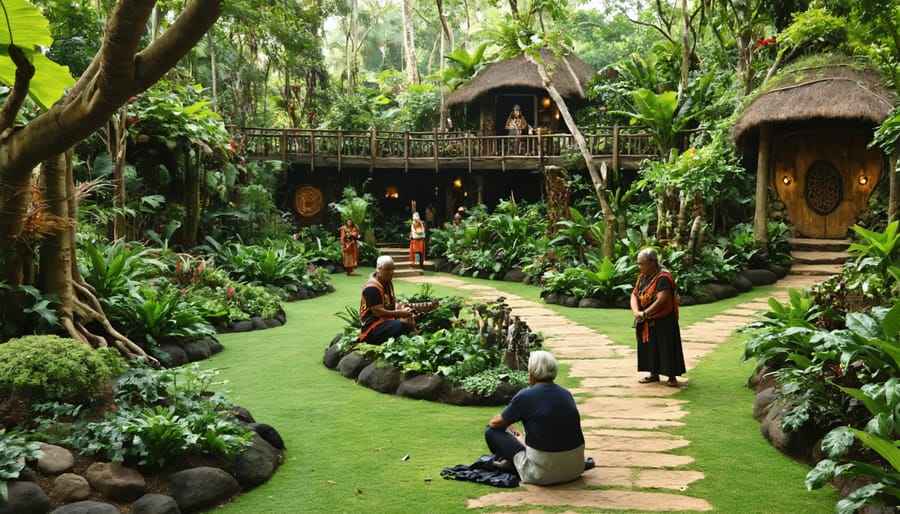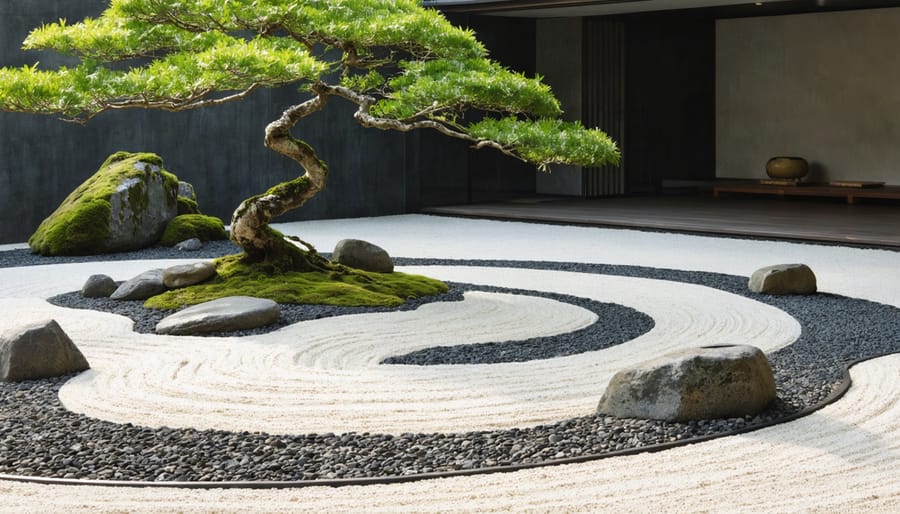Step into a living museum where plants tell stories of ancient civilizations, traditional healing practices, and cultural rituals. Ethnobotanical gardens stand as vibrant bridges between human heritage and the natural world, preserving not just plant species but the profound relationships different cultures have forged with them over millennia. These specialized gardens showcase medicinal herbs used by indigenous healers, sacred plants central to religious ceremonies, and traditional food crops that have sustained communities for generations. Unlike conventional botanical gardens that primarily focus on plant taxonomy and conservation, ethnobotanical gardens weave together botanical science with anthropology, celebrating the rich tapestry of human-plant relationships that have shaped our societies. From the carefully tended Aztec medicinal gardens to modern collections preserving Native American plant wisdom, these living laboratories offer visitors a unique opportunity to explore how different cultures have understood, used, and revered the plant world throughout history.
The Rich History of Ethnobotanical Gardens
From Ancient Medicine to Modern Conservation
The journey of ethnobotanical gardens spans thousands of years, beginning with ancient healing gardens where shamans and medicine workers cultivated therapeutic plants. These early gardens served as living pharmacies, where knowledge of plant properties was passed down through generations. As exploration and trade expanded, particularly during the age of discovery, colonial garden influences brought new dimensions to these specialized spaces.
By the 18th century, ethnobotanical gardens evolved beyond their medicinal roots to become vital centers of cultural preservation. They began documenting traditional plant knowledge, cultivation methods, and the deep connections between plants and human communities. Today’s ethnobotanical gardens serve as living museums, protecting not just plant species but entire cultural traditions and practices.
Modern ethnobotanical gardens play a crucial role in conservation efforts, preserving endangered plant species and the traditional knowledge associated with them. They’ve become educational hubs where visitors can learn about sustainable practices, indigenous wisdom, and the importance of protecting both natural and cultural heritage for future generations. These gardens remind us that plant conservation isn’t just about saving species – it’s about preserving the human stories and traditions woven into our relationship with the natural world.

Traditional Knowledge Preservation
Ethnobotanical gardens serve as living libraries of traditional plant knowledge, preserving centuries of indigenous wisdom for future generations. Local elders and knowledge keepers work alongside garden staff to document plant uses, cultivation methods, and cultural ceremonies associated with each species. Through hands-on workshops and guided tours, these gardens create meaningful connections between indigenous communities and visitors, sharing stories of how plants have been used for food, medicine, and spiritual practices.
Many gardens also maintain seed banks of traditional varieties and teach sustainable harvesting techniques that have been passed down through generations. By creating spaces where cultural practices can be actively demonstrated and shared, ethnobotanical gardens help ensure that valuable traditional knowledge isn’t just preserved in books but remains alive and relevant in today’s world. This living approach to preservation allows communities to maintain their cultural identity while adapting traditional practices to contemporary challenges.
Key Elements of an Ethnobotanical Garden
Plant Selection and Organization
In ethnobotanical gardens, plant selection and organization follow a thoughtful approach that honors cultural connections and traditional uses. Rather than arranging plants purely by botanical families or aesthetic appeal, these gardens group plants according to their cultural significance and historical relationships with specific communities.
Plants are typically chosen based on their traditional uses: medicinal herbs, ceremonial plants, food crops, and materials used for crafts or building. Many gardens organize these selections into themed areas that tell stories of different cultures or showcase specific uses. For example, you might find a Native American medicine wheel garden featuring sacred herbs, or a Mediterranean section highlighting plants used in traditional cooking.
The layout often incorporates educational elements, with clear pathways and interpretive signs explaining each plant’s cultural importance. Some gardens arrange plants geographically, creating distinct zones that represent different regions and their ethnobotanical heritage. Others organize them by use categories, such as fiber plants, dye plants, or ceremonial species.
Special attention is given to preserving rare varieties and heirloom plants that hold particular significance to indigenous communities, ensuring these living cultural artifacts continue to thrive for future generations.
Cultural Interpretation Features
Cultural interpretation features in ethnobotanical gardens serve as living classrooms, weaving together stories of plant traditions and human heritage. Interactive signage and educational panels guide visitors through the cultural significance of each plant species, often including traditional names, historical uses, and their roles in ceremonies or daily life.
Many gardens incorporate storytelling circles and spiritual garden spaces where groups can gather to share knowledge and experiences. Traditional structures, such as Native American medicine wheels or Japanese tea houses, provide authentic settings for cultural demonstrations and workshops.
Audio guides and mobile apps enhance the visitor experience by offering recorded stories from community elders, traditional music, and detailed plant information in multiple languages. Seasonal programs often align with traditional harvesting calendars, allowing visitors to participate in hands-on activities like basket weaving, herbal medicine preparation, or traditional food preparation.
Garden layouts frequently follow cultural patterns, with plants grouped according to their traditional uses – healing, food, fiber, or ceremony – making it easier for visitors to understand the interconnected relationship between plants and people across different cultures.

Conservation Practices
Conservation practices in ethnobotanical gardens focus on protecting plant species that hold cultural and medicinal significance. Seeds from rare plants are carefully collected and stored in temperature-controlled seed banks, while detailed records document traditional uses and growing conditions. Garden staff often work closely with indigenous communities to understand proper cultivation methods and maintain the plants’ cultural context. Propagation techniques like cuttings and division help preserve vulnerable species, while careful soil management and organic practices ensure long-term sustainability. Many gardens also participate in plant exchange programs with other institutions, creating backup collections that safeguard against potential losses. Educational programs teach visitors about conservation importance, helping ensure these valuable plant traditions continue for future generations.
Creating Your Own Mini Ethnobotanical Garden
Planning Your Cultural Plant Collection
Begin your cultural plant collection journey by researching plants that hold significance in different traditions and cultures. Start by exploring your local climate zone and understanding which culturally important plants can thrive in your area. Make a list of potential plants, considering factors like available space, sunlight, and water requirements.
Connect with local indigenous communities or cultural organizations to learn about traditional plant uses and cultivation methods. Many native plants have deep cultural significance and are often well-adapted to your region’s conditions. Consider including medicinal herbs, food crops, and plants used in ceremonies or crafts.
Create a seasonal planting calendar that aligns with both cultural significance and growing conditions. For example, you might include sacred herbs that bloom during important festivals or food plants harvested during traditional celebration times.
Document your research in a garden journal, noting each plant’s cultural significance, growing requirements, and traditional uses. This will help you develop a meaningful collection that honors cultural heritage while ensuring successful growth. Remember to source your plants ethically from reputable suppliers who respect cultural practices and sustainable harvesting methods.
Start small with a few key species and gradually expand your collection as you gain experience and knowledge. This approach allows you to learn about each plant’s needs and cultural importance while creating a thriving, meaningful garden space.
Design and Layout Tips
When designing your ethnobotanical garden, start by creating distinct zones that represent different cultural or geographical areas. Consider arranging plants in storytelling circles or along winding paths that guide visitors through various traditional uses and cultural significance. Create a sacred garden sanctuary atmosphere by incorporating traditional elements like stone circles or meditation spaces.
Include clear, engaging signage that describes not just plant names, but also their cultural significance and traditional uses. Use weatherproof labels with both scientific and common names, along with the culture or region of origin. Consider adding QR codes that link to more detailed information about each plant’s ethnobotanical history.
Group plants according to their traditional uses – medicinal, culinary, ceremonial, or craft-related. This makes it easier for visitors to understand the practical applications of different species. Create focal points using larger specimens or culturally significant arrangements, and ensure pathways are wide enough for comfortable exploration.
Add seating areas where visitors can pause and reflect, preferably near fragrant or visually striking plants. Consider incorporating traditional structures like pergolas or shade houses that reflect the cultural themes of your garden while providing practical growing spaces for shade-loving species.
Maintenance and Documentation
Proper maintenance of an ethnobotanical garden requires both horticultural expertise and careful documentation of cultural knowledge. Keep detailed records of each plant’s traditional uses, stories, and cultural significance alongside standard growing requirements. Create a maintenance calendar that includes not only watering and pruning schedules but also optimal times for harvesting based on traditional practices.
Maintain a garden journal documenting plant responses to different care techniques, seasonal changes, and successful propagation methods. Photograph plants throughout their growth cycles and record any traditional ceremonies or practices associated with their care. Label plants with both scientific and traditional names, and include basic cultural information on weather-resistant signs for visitors.
Consider partnering with local indigenous communities or cultural groups to ensure accurate documentation of plant uses and traditions, while respecting any cultural protocols regarding the sharing of traditional knowledge.

Famous Ethnobotanical Gardens to Visit
For those eager to experience ethnobotanical gardens firsthand, several world-renowned destinations offer incredible opportunities to explore the relationship between plants and human cultures. The New York Botanical Garden’s Native Plant Garden showcases indigenous species that Native Americans have used for centuries, featuring educational programs about traditional plant uses and conservation efforts.
In Hawaii, the Amy B.H. Greenwell Ethnobotanical Garden on the Big Island presents visitors with an extraordinary collection of native Hawaiian plants, including traditional canoe plants brought by Polynesian voyagers. The garden offers hands-on workshops where visitors can learn about traditional Hawaiian farming practices and medicinal plant preparations.
The Desert Botanical Garden in Phoenix, Arizona, maintains an outstanding collection of desert plants, with special emphasis on how indigenous peoples of the Sonoran Desert used local flora for food, medicine, and crafts. Their guided tours share fascinating stories about desert survival and plant wisdom passed down through generations.
In Mexico, the Jardín Etnobotánico de Oaxaca stands out for its impressive collection of regional plants, particularly those used in local cuisine and traditional medicine. The garden’s unique architecture integrates seamlessly with its plant collections, creating a stunning showcase of Mexican botanical heritage.
These gardens not only preserve important plant species but also serve as living museums, documenting and celebrating the profound connections between plants and human cultures across different regions and traditions.
Ethnobotanical gardens stand as living libraries of cultural wisdom and natural diversity, bridging the gap between traditional knowledge and modern conservation efforts. These sacred spaces not only preserve rare and medicinal plants but also protect the stories, traditions, and practices that have been passed down through generations. By maintaining these gardens, we ensure that future generations can learn from and build upon the profound relationship between people and plants that has shaped human civilization. As climate change and urbanization continue to threaten both biodiversity and cultural heritage, ethnobotanical gardens become increasingly vital sanctuaries. They remind us that gardening is more than just growing plants – it’s about nurturing connections between nature and human culture, preserving ancient wisdom, and inspiring sustainable practices for tomorrow’s world.




